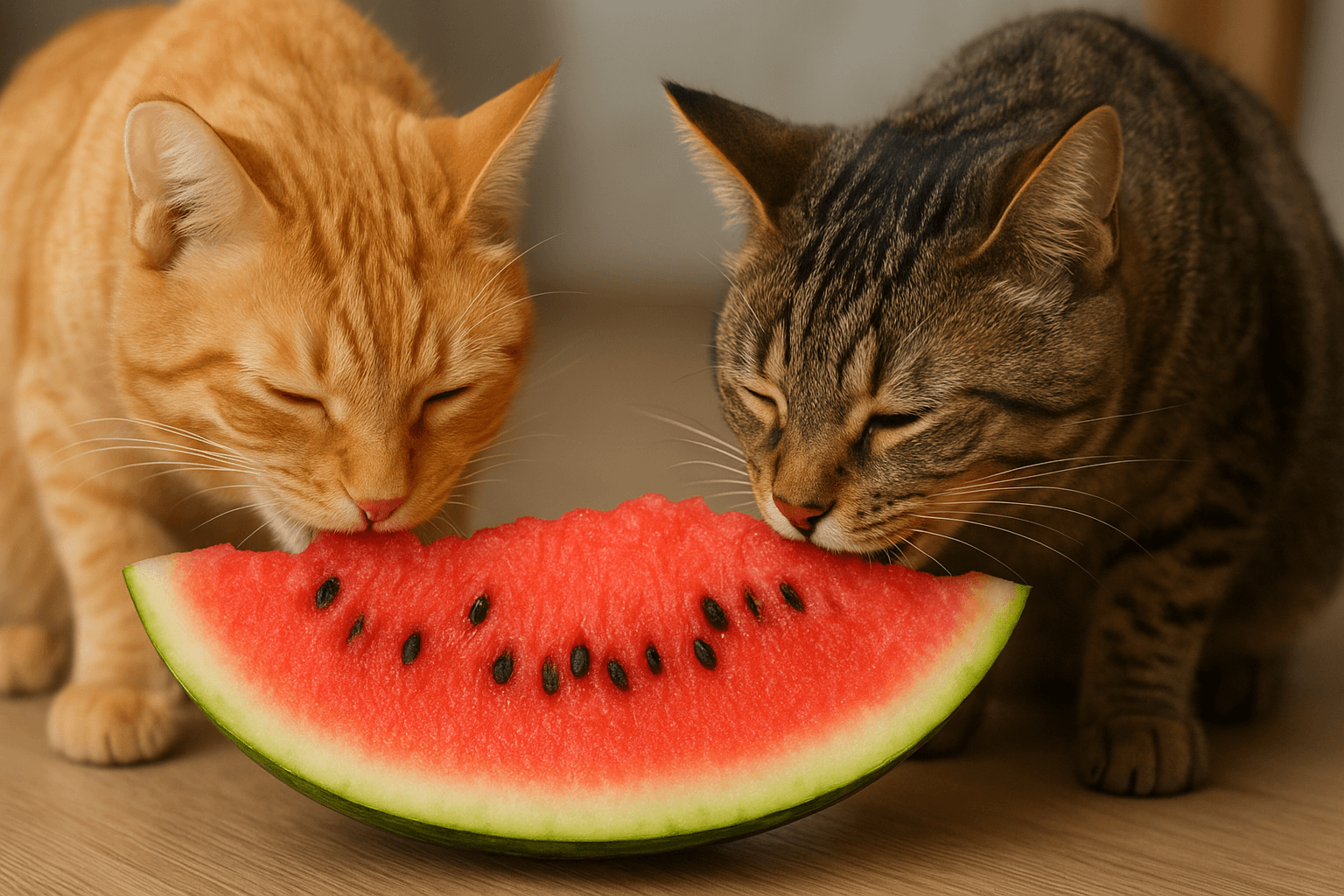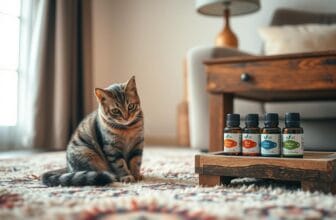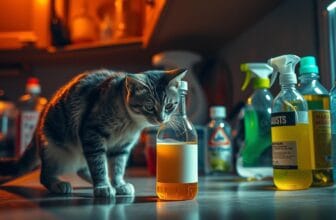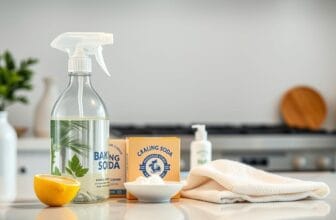
Table of Contents
Do you have to choose between beautiful plants and your cat’s safety? What if you could have a stunning home garden that’s safe for your cat?
Many pet owners find it hard to pick safe houseplants. Plants like Peace Lilies and Sago Palms can be harmful to curious cats.
Finding cat-safe plants is more than just avoiding danger. It’s about creating a vibrant, safe space for both you and your pet. Pet-friendly plants let you enjoy greenery while keeping your pet safe.
This guide will show you how to pick stunning, safe plants for your home. Whether you’re a plant expert or a new pet owner, you’ll learn to create a beautiful, safe garden for everyone.
Understanding the Importance of Pet-Safe Plants
As a cat owner, making your home safe is more than just furniture and routines. Your plants can be a hidden danger to your pets. Knowing which plants are toxic to cats is key to keeping them healthy and safe.
Many houseplants contain chemicals that can harm or even kill cats. The ASPCA plant guidelines are a vital resource for pet owners. They help you avoid plants that could be harmful.
Why Common Houseplants Can Be Dangerous
Some plants may look nice but can harm your cat. These plants have toxins that can cause a range of problems, from mild to severe.
- Potential plant toxins can cause digestive problems
- Some plants trigger skin irritation
- Certain botanical compounds may impact nervous system function
The Role of ASPCA Guidelines in Plant Selection
The ASPCA offers lists and resources to guide pet owners in choosing plants. Their guidelines help you pick plants that are safe for your home.
| Toxicity Level | Potential Risks | Recommended Action |
|---|---|---|
| Mild | Temporary digestive issues | Monitor pet, contact veterinarian |
| Moderate | Significant health complications | Immediate veterinary consultation |
| Severe | Potential life-threatening conditions | Emergency medical intervention |
Health Risks of Toxic Plants to Cats
Cats are curious and might eat plants. It’s important to know the risks. Symptoms of plant poisoning include vomiting, lethargy, difficulty breathing, and changes in urination.
Always consult your veterinarian if you suspect your cat has ingested a toxic plant.
Creating a Pet-Friendly Indoor Garden
Creating a pet-friendly indoor garden needs careful planning and creativity. Your home can become a safe, beautiful green space for both plants and pets. The key is in strategic placement and choosing the right plants.
Here are some important tips for your pet-friendly indoor garden:
- Choose stable, heavy planters that prevent tipping
- Select non-toxic plants recommended by veterinarians
- Position plants out of direct pet reach
- Use elevated shelves or hanging displays
Light and placement are key in a pet-friendly indoor garden. Cats are curious, so use barriers to keep them away from plants. Decorative screens or plants in hard-to-reach spots can help.
“A well-designed indoor garden can be both beautiful and safe for your pets.” – Veterinary Plant Safety Association
Your garden should look good and be safe for animals. Use vertical gardening, sturdy stands, and change plant spots to keep it interesting and safe.
Follow these tips to make a beautiful indoor garden that’s safe for your pets.
Popular Cat Safe Plants for Your Home
Creating a pet-friendly indoor garden is easy and stylish. Cat owners can pick from many plants that look great and are safe for cats. You can choose from cat-friendly succulents to safe flowering plants for cats to brighten your home.
Choosing the right plants is important for your cat’s safety and a lush home. Let’s look at some great plant options that will make you and your cat happy.
Succulents and Desert Plants
Cat-friendly succulents are perfect for those who want easy-to-care-for plants. Here are some top picks:
- Haworthia (Zebra Plant)
- Echeveria
- Burro’s Tail
- Sempervivum (Hen and Chicks)
Flowering Options
Safe flowering plants for cats can add color to your home. Check out these beautiful and safe options:
- African Violet
- Orchids
- Christmas Cactus
- Calathea
Leafy Greens and Ferns
Soft, green plants can make your home look great while keeping your cat safe. Here are some pet-friendly leafy plants:
- Spider Plant
- Boston Fern
- Parlor Palm
- Peperomia
Pro Tip: Always double-check plant safety with the ASPCA’s toxic plant database before bringing any new greenery home.
By picking cat-friendly plants, you can make a beautiful, green space safe for your cat. Always watch your cat around new plants and give them other things to do to avoid nibbling.
Best Low-Maintenance Options for Busy Pet Parents
Looking for cat safe plants that are easy to care for can be a big help for busy pet owners. These plants are perfect for adding some green to your space without needing to spend a lot of time on them.
Here are some tough plants that don’t need much care:
- Spider Plant: Adaptable and virtually indestructible
- Boston Fern: Tolerates various light conditions
- Ponytail Palm: Drought-resistant and cat-friendly
- Haworthia Succulents: Minimal watering required
Even if you’re always on the go, you can still have plants indoors. These cat safe plants are made to be easy to care for and look great with little effort.
| Plant Name | Watering Frequency | Light Requirements | Pet Safety |
|---|---|---|---|
| Spider Plant | Every 1-2 weeks | Indirect light | 100% Safe |
| Boston Fern | Weekly | Indirect/Filtered light | Non-toxic to cats |
| Ponytail Palm | Every 2-3 weeks | Bright indirect light | Cat-friendly |
| Haworthia | Monthly | Bright, indirect light | Safe for pets |
To keep your plants happy and healthy, know what they need. Choose plants that fit your home’s light and your schedule. These plants are not only beautiful but also safe for your pets.
Pro tip: Always research specific care instructions for each plant to ensure optimal growth and pet safety.
Decorative Plants That Keep Cats Safe
Creating a beautiful home while keeping cats safe is key. Choosing decorative cat safe plants is the answer for pet owners. These plants let you enjoy greenery without harming your cat. By picking and placing pet-friendly hanging plants, you can make your home lush and safe.

When picking indoor plants, think about looks and safety. It’s important to pick plants that are safe for your cat and look great.
Hanging Plants: Elevated Greenery
Pet-friendly hanging plants are a great choice for cat owners. They keep plants out of reach and add beauty to your home.
- Spider Plant: Non-toxic and visually striking
- Boston Fern: Lush and completely safe for cats
- String of Pearls: Unique cascading design
Floor Plants: Ground-Level Greenery
Some plants are perfect for the floor, offering strong foliage that cats can’t harm.
- Parlor Palm: Elegant and cat-friendly
- Calathea: Vibrant patterns, zero toxicity
- African Violet: Compact and colorful
Windowsill Options: Sunny and Safe
Windowsills are great for cat-friendly plants that love sunlight.
- Echeveria Succulents: Compact and safe
- Haworthia: Tiny, sculptural plants
- Air Plants: Minimal care, maximum style
Pro Tip: Always check plant safety with the ASPCA toxic plant database before bringing new plants home.
Air-Purifying Cat-Safe Plant Options
Creating a healthy home for you and your pets is now easier. Air-purifying cat safe plants make your space beautiful and clean the air. They keep your pets safe from harmful toxins.
- Spider Plants: These plants remove harmful chemicals and are safe for cats
- Boston Ferns: They clean the air naturally
- Areca Palms: Great at removing toxins from the air
- Bamboo Palms: They have strong air-cleaning abilities
Choose the right spot for these plants. Place them in areas with indirect light and out of your cat’s reach. This way, your pets can be safe, and the plants can clean the air.
These plants are a natural way to fight indoor air pollution. They take in bad chemicals, release oxygen, and make your home safer for all.
Pro tip: Always research each plant’s specific care requirements to ensure they thrive in your home.
Indoor Palm Varieties Safe for Felines
Cat owners can relax knowing there are safe indoor palms for pets. These tropical plants make your home look great and are safe for your pets.

Cat-friendly palm plants are both beautiful and safe for homes with pets. They bring a tropical feel without harming your feline friends.
Popular Palm Species for Cat Owners
- Parlor Palm (Chamaedorea elegans): A low-maintenance option perfect for low-light areas
- Areca Palm: Graceful fronds that are completely non-toxic to cats
- Ponytail Palm: Unique appearance with zero toxicity concerns
- Bamboo Palm: Adds vibrant greenery without endangering pets
Essential Care Requirements
To keep safe indoor palms for pets, know their needs. Most cat-friendly palms like indirect light and consistent moisture, but not too much water.
| Palm Variety | Light Needs | Watering Frequency |
|---|---|---|
| Parlor Palm | Low to Medium | Once per week |
| Areca Palm | Bright, Indirect | Twice per week |
Strategic Placement Tips
Think carefully about where to put cat-friendly palm plants. Choose spots with stable temperatures, away from drafts or heating vents.
- Keep palms on elevated stands to discourage cat interaction
- Use decorative barriers if needed
- Rotate plant locations to maintain interest and prevent boredom
By picking the right palms and placing them wisely, you can have a beautiful, safe indoor garden. It’s a place where you and your cats can both enjoy.
Seasonal Cat-Safe Plants for Year-Round Beauty
Creating a vibrant indoor garden that’s safe for your cats is key. You can change your home’s look with plants that are safe for cats all year. This way, your home stays beautiful and your cats stay safe.
Looking for plants that are safe for pets all year keeps your home interesting. Some plants are special during different seasons:
- Spring: African Violets bloom with delicate purple flowers
- Summer: Spider Plants offer cascading green foliage
- Autumn: Boston Ferns display rich green textures
- Winter: Christmas Cacti produce vibrant holiday blooms
When picking plants, think about how they grow and what they need. For example, Christmas Cacti are safe for cats and add color in winter. They make your home festive without risking your pet’s health.
Choose a variety of plants and change them with the seasons. This keeps your garden fresh and fun all year. It makes your home a lively and engaging place.
Pro Tip: Always check if a plant is safe with the ASPCA’s toxic plant database before bringing it home.
By picking the right plants, you can have a beautiful garden that’s safe for your cats. This way, you and your pets can enjoy a lovely indoor space together.
Strategic Plant Placement and Cat Protection

Creating a space where plants and cats can live together needs careful planning. Cats’ curiosity can harm plants, but the right placement can keep them safe. This way, both your plants and pet can enjoy their home.
To protect plants from cats, it’s important to know their habits and set up barriers. Here are some effective strategies:
- Elevate plants on high shelves or hanging planters out of your cat’s reach
- Use decorative barriers like small fences or mesh screens around plant areas
- Place plants in rooms with doors that can be closed when unsupervised
Protecting plants isn’t just about keeping them high. You can also use other creative ways to keep cats away:
- Sprinkle natural deterrents like citrus peels or coffee grounds on soil
- Cover plant soil with decorative pebbles to prevent digging
- Use aluminum foil or double-sided tape around plant bases
Every cat is different. Watch how your cat interacts with plants and change your plan if needed. The aim is to make a safe space where plants and cats can both flourish.
How to Introduce New Plants to Cat Households
Introducing plants to cats needs a careful plan. It’s about making a space where cats and plants can live together well. This requires patience and knowing how to do it right.
Introducing cat-safe plants is more than just adding a new plant. You need a good plan to keep both plants and cats safe and happy.
Gradual Introduction Methods
Here’s how to introduce a new plant:
- Start with one plant in a spot cats can’t easily get to.
- Use high places or hanging planters.
- Put plants in rooms with doors that can be closed.
- Change where plants are to keep cats curious.
Monitoring Cat Behavior
Watch how your cat acts around new plants. Look for:
- Too much sniffing.
- Trying to chew leaves.
- Pawing at the plant or its pot.
- Being too interested or mean to the plant.
“Understanding your cat’s behavior is key to successful plant integration.” – Veterinary Plant Safety Association
Creating Safe Boundaries
Keep plants and cats safe with these tips:
- Use citrus sprays around the plants.
- Put up decorative screens as barriers.
- Give cats other things to play with.
- Try bitter apple spray on leaves.
Introducing plants to cats takes time and effort. Stay patient and flexible as you go through the process.
Maintaining Healthy Plants While Protecting Pets
Keeping your indoor plants healthy and safe for your cat is important. You need to care for your plants without risking your pet’s health.
Here are some key steps for caring for plants that are safe for cats:
- Choose organic, pet-safe fertilizers
- Use natural pest control methods
- Clean plant leaves with gentle, non-toxic solutions
- Monitor plant and cat interactions regularly
Watering and humidity are key for plant health. Each plant has its own needs. It’s important to know what each plant requires.
| Plant Type | Water Frequency | Humidity Preference | Pet Safety |
|---|---|---|---|
| Spider Plant | Weekly | Moderate | Safe for cats |
| Boston Fern | 2-3 times weekly | High | Non-toxic |
| Parlor Palm | When top soil is dry | Medium | Cat-friendly |
Pruning is also crucial for plant health. Remove dead or yellowing leaves carefully. Use clean, sharp tools to avoid damage and disease.
Always check the specific care needs for each plant. Some plants need more care than others, especially when pets are around. By following these tips, you can make a safe space for both your plants and pets to flourish.
Common Signs of Plant Toxicity in Cats
It’s important to know the signs of plant poisoning in cats. Cats are curious and might eat plants that are bad for them. This can lead to serious health problems.
Here are the key signs to watch for:
- Gastrointestinal distress: Vomiting, diarrhea, or too much drooling
- Sudden changes in behavior or energy levels
- Difficulty breathing or wheezing
- Skin irritation or unexpected rashes
- Unusual lethargy or weakness
Some severe symptoms of plant poisoning include:
- Tremors or seizures
- Dilated pupils
- Increased heart rate
- Loss of coordination
If you suspect your cat has ingested a toxic plant, contact your veterinarian immediately!
Some plants are more dangerous than others. Plants like lilies, sago palms, and pothos are especially risky for cats. If you see any strange symptoms, act fast.
Preventing plant poisoning is the best way. Always check the plants you bring home. Make sure your cat’s environment is safe.
Conclusion
Creating pet-friendly green spaces is more than a design choice. It’s a commitment to your cat’s health and your home’s look. Cat safe plants offer a safe living space that protects your pet and adds beauty indoors.
Your journey to a safe botanical sanctuary begins with careful plant selection and placement. Choose non-toxic plants like spider plants, Boston ferns, and African violets. This way, you can make your living space a vibrant, cat-friendly oasis that supports your pet’s health and your design goals.
Introducing new plants requires patience and watching your cat’s behavior. Create special plant areas and watch for any signs of curiosity or discomfort. With careful planning, plants and pets can live together beautifully, making your home more enjoyable.
Start exploring cat-safe plants today. Your furry friend and your indoor space will both benefit from prioritizing safety, beauty, and mutual respect in your home.
FAQ
What makes a plant safe for cats?
A cat-safe plant won’t harm your feline friend if they eat it. These plants are on the ASPCA’s safe list. They don’t have harmful compounds for cats.
How can I tell if a plant is toxic to my cat?
Check the ASPCA’s plant database or ask your vet. Signs of a toxic plant include vomiting, diarrhea, and lethargy. These symptoms happen after your cat touches or eats the plant.
What are some easy-to-care-for cat-safe plants?
Spider Plants, Boston Ferns, African Violets, and Parlor Palms are great. They’re easy to care for and safe for cats.
How can I prevent my cat from eating my plants?
Keep plants out of reach on high shelves. Use sprays to deter them. You can also give them cat grass or catnip instead.
Are succulents safe for cats?
Not all succulents are safe. Echeveria, Haworthia, and Sempervivum are okay. But Jade Plants and Aloe Vera are toxic and should be avoided.
What should I do if my cat eats a potentially toxic plant?
Call your vet or the ASPCA Animal Poison Control Center right away. Remove any plant material from your cat’s mouth. Collect a plant sample and get professional advice quickly.
Can plants improve air quality in homes with cats?
Yes, many safe plants like Spider Plants and Boston Ferns purify the air. They’re good for your home and safe for your cat.
How often should I rotate my cat-safe plants?
Rotate plants seasonally for a fresh look and to keep them healthy. Plants like Christmas Cactus and African Violets add seasonal beauty.
Are there any seasonal cat-safe plants?
Yes, there are plants for every season. Christmas Cactus for winter, African Violets for spring, Boston Ferns for summer, and Spider Plants all year round are safe for cats.
How can I create a pet-friendly indoor garden?
Choose safe plants and use elevated surfaces. Create barriers and place plants where cats can’t easily reach them. This way, your garden will be beautiful and safe for your pets.







